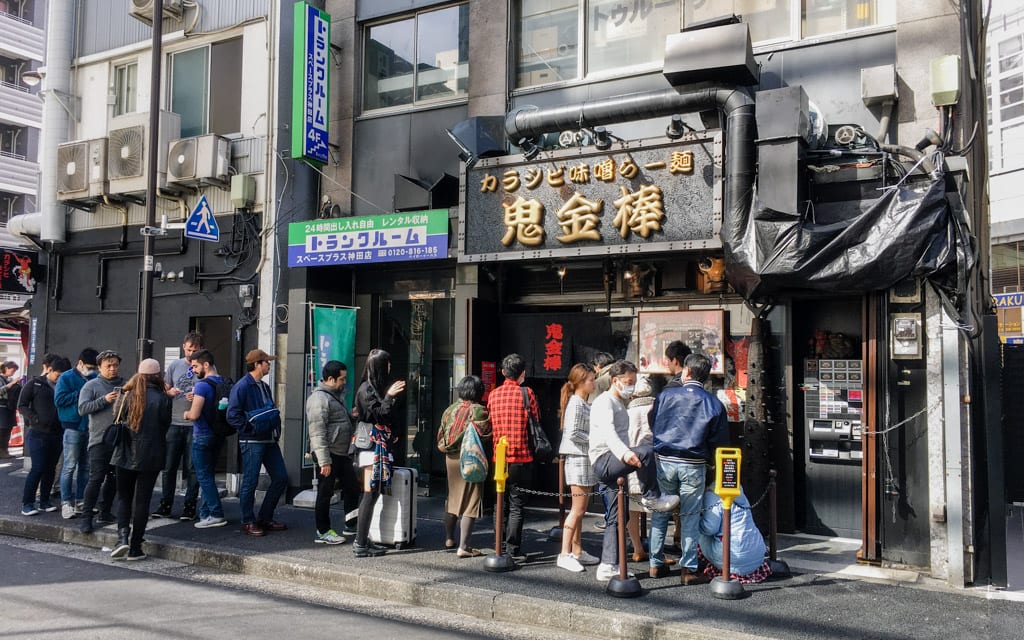
If you are looking for the spiciest ramen in Tokyo, Japan, you go to Karashibi Miso Ramen Kikanbo. At Kikanbo, fiery bowls of ramen are prepared with both chili pepper and Sichuan pepper, giving your mouth a burning, numbing sensation. While Japan might not be known for its spicy cuisine, if you are a lover of spicy foods or spicy ramen, then Kikanbo is a must.
If you are looking for more information about Tokyo and Japan, I highly recommend you pick up a guidebook such as Lonely Planet Best of Tokyo 2020
Table of Contents
Waiting in Line at Karashibi Miso Ramen Kikanbo
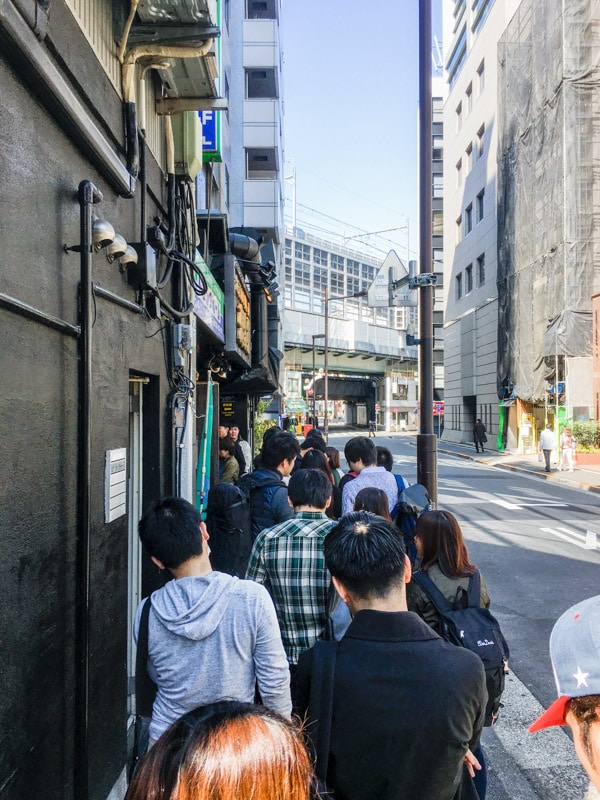
It was a Sunday afternoon in Tokyo. As I made my way from Kanda Station towards Kikanbo, the streets seemed empty. Businesses in the area were closed for the weekend. It was like a ghost town, which is something rarely found in Tokyo.
I knew before my visit to expect a line. Since it was a Sunday, I was hoping the line would be short. When I turned the corner onto the street where Kikanbo was located, I was shocked to see how many people were already in line. While I never enjoy waiting in line for food, I knew the wait would be worth it.
If you are planning on visiting, prepare for a wait.
One more thing to note. Kikanbo had another branch located a few doors down that served tsukemen ramen.
Vending Machine
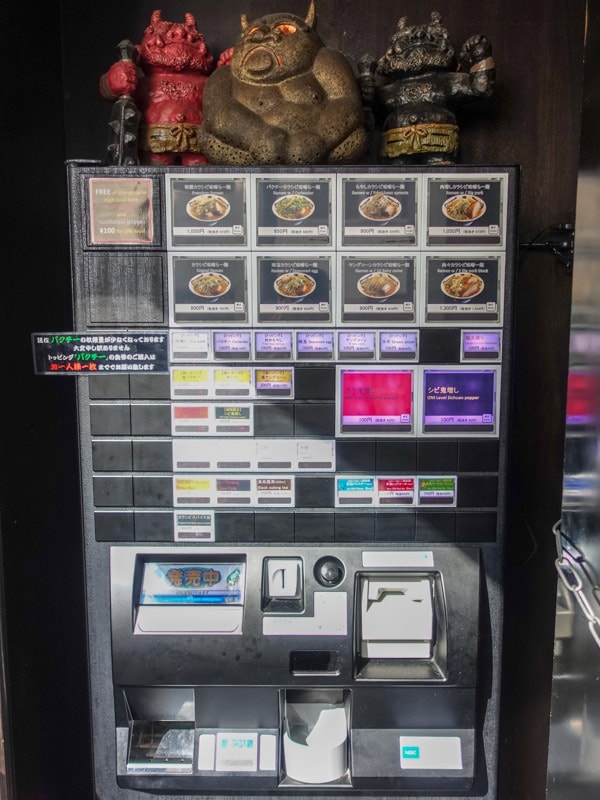
Before standing in line, I used the vending machine located outside the restaurant to purchase my ramen. Vending machines are a common sight at ramen joints all over Japan. I wish more restaurants would use them.
If you have never used a vending machine to purchase ramen before, then don’t worry, it’s easy. Simply put your money in the machine, select what you want, take your ticket, and take your change. The machine accepted 1000, 2000, 5000, and 10000 yen banknotes. Also accepted were 10, 50, 100, and 500 yen coins.
Another great thing about the vending machine at Kikanbo was that the options were listed in both Japanese and English. This made ordering a whole lot easier for those who do not speak Japanese like myself.
Ramen Tickets
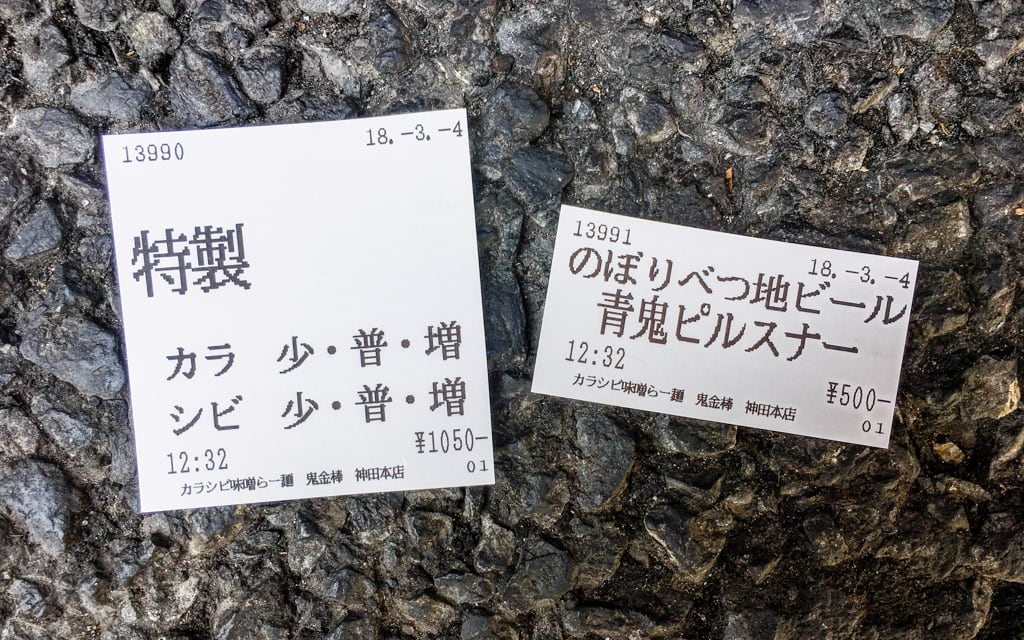
Hold on to your ramen tickets and give them to any staff member when asked. I was asked for my ticket, along with what heat levels I would like, while I was still waiting in line. The larger ticket on the left was for the Premium Ramen while the smaller ticket on the right was for a beer. A cold beverage to counter the heat was a must for me on this visit.
Levels of Heat
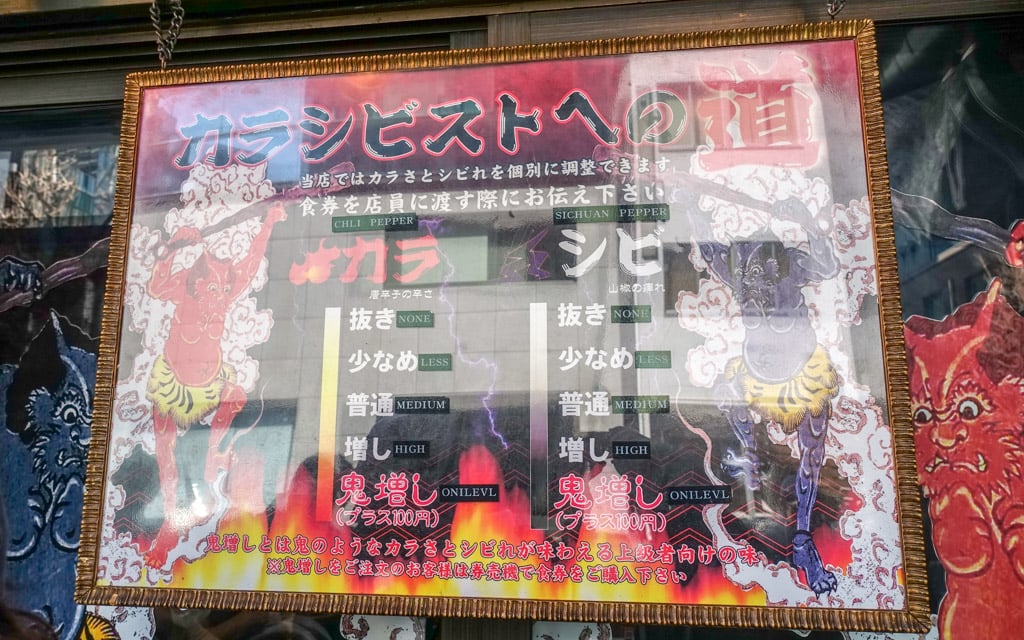
Are you nervous about trying spicy foods that will make you sweat through your clothes and burn your mouth? No need to worry. At Kikanbo, you could choose specific heat levels for your bowl of ramen.
You could customize each bowl with the perfect amount of chili pepper (kara) and Sichuan pepper (shibi). Most of the heat comes from the chili pepper. Surprisingly, Sichuan peppers are not spicy. They make your mouth tingle, almost numbing it.
There were five levels for you to choose from. You could select none, less, medium, high, and oni or devil level for both the chili and Sichuan pepper. In Japanese folklore, oni is a type of supernatural devil or ogre. Not surprisingly, Kikanbo translates to “ogre’s iron club.”
If you want oni level, it will cost you an extra 100 yen (or about $0.90) for each level. Any of the first four levels came included at no additional cost.
Which heat level to order?
If you are a lover of spicy foods, I recommend ordering your ramen with a chili pepper level of high or oni. This will give you the perfect amount of heat. As for the Sichuan pepper, while not spicy, I wouldn’t go higher than the high level unless you want your mouth to be numb to the point where you can’t talk. It was that overpowering.
If you don’t like spicy foods, no need to worry. You can order your ramen without any pepper or one of the lower levels. The broth was still flavorful enough and packed with toppings that even without pepper, it would still be delicious and worth the wait in line.
Karashibi Miso Ramen Kikanbo Menu
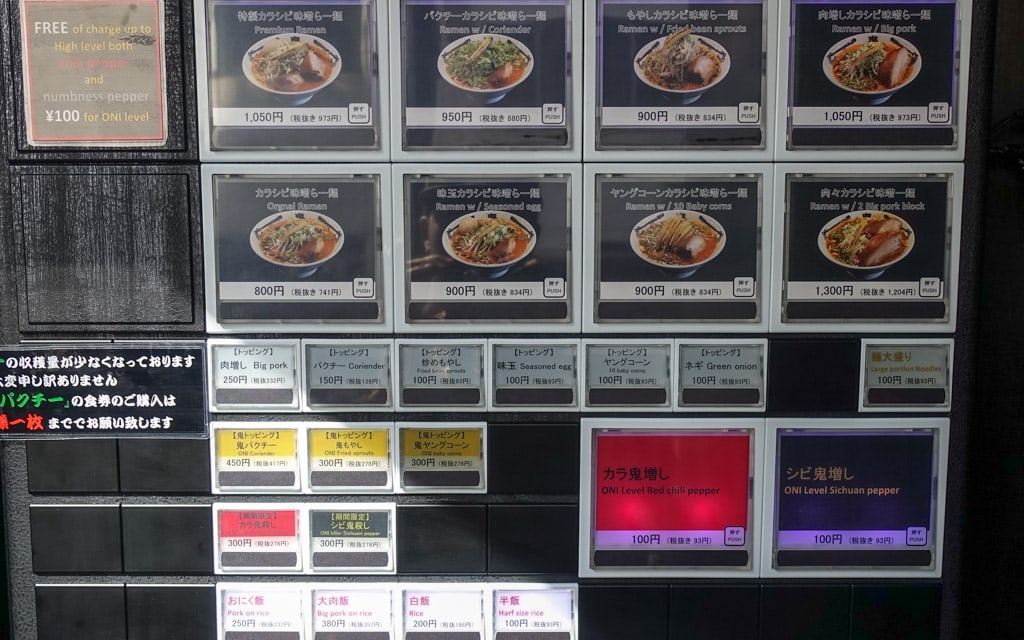
The menu at Karashibi Miso Ramen Kikanbo, found on the vending machine, was simple, but there were more options than met the eye.
The two main options were Premium Ramen (1,050 yen or about $9.51) and Original Ramen (800 yen or about $7.25). If you want to customize your ramen, get the original ramen. If you want everything included, go for the premium ramen.
Other options included ramen with coriander, fried bean sprouts, pork, seasoned egg, or baby corn.
You could also order toppings a la carte. Available toppings were big pork (250 yen or about $2.25), coriander (150 yen or about $1.35), fried bean sprouts (100 yen or about $0.90), seasoned egg (100 yen or about $0.90), baby corn (100 yen or about $0.90), and green onion (100 yen or about $0.90). If you want a large portion of noodles, that will cost you an extra 100 yen.
As mentioned before, if you want the oni level chili pepper or Sichuan pepper, that will cost 100 yen each. Levels beneath the oni level came with no charge.
Want more heat? You’re in luck. You had Oni Coriander (450 yen or about $4.05), Oni Fried Sprouts (300 yen or about $2.70), Oni Baby Corn (300 yen or about $2.70), Oni Killer Red Chili Pepper (300 yen or about $2.70), or the Oni Killer Sichuan Pepper (300 yen or about $2.70).
Other than ramen, sides included Pork on Rice (250 yen or about $2.25), Big Pork on Rice (380 yen or about $3.42), Rice (200 yen or about $1.80), and Half Size Rice (100 yen or about $0.90).
Drinks included beers (500-700 yen or about $4.50-$6.30), Coca-Cola (200 yen or about $1.80), and Black Oolong Tea (200 yen or about $1.80).
Devilish Interior of Kikanbo
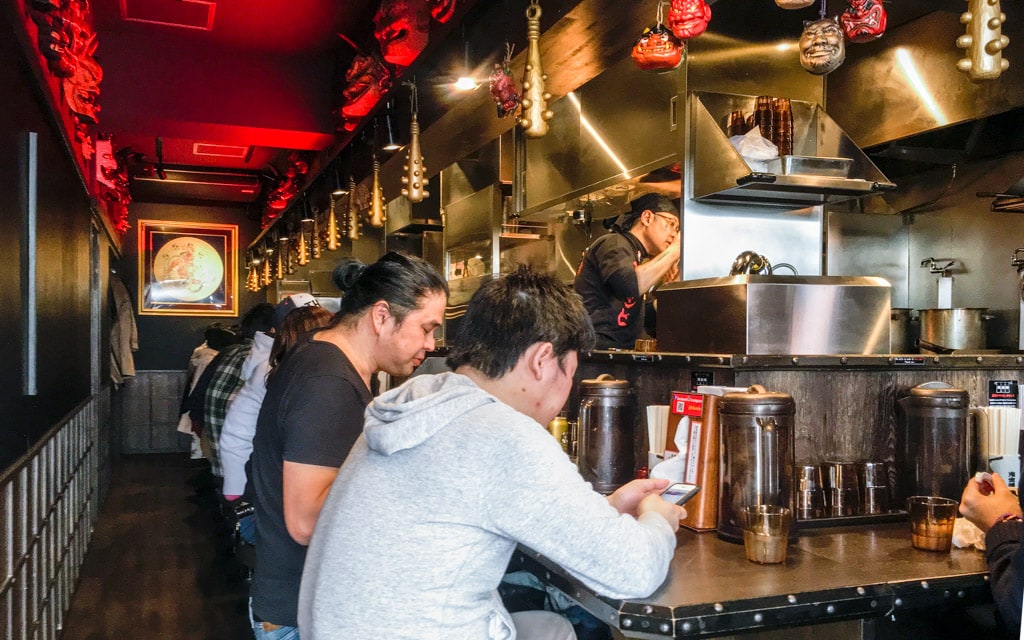
After waiting about 40 minutes, I finally made past the door and inside of the restaurant. The smell of pork and garlic hit me immediately. It was intoxicating.
When I walked through the door, I knew I wasn’t in any normal ramen restaurant. It was like I was transported to another world. The interior was dark and eerie like a dungeon. There was a devil theme with black walls and bright red ceilings.
Kabuki masks, clubs, and devil themed ornaments were scattered around the restaurant including on the ceilings. And, to make the experience more uncanny, there was Japanese drum music playing in the background. I could tell I was about to eat a fiery bowl of ramen. I was excited.
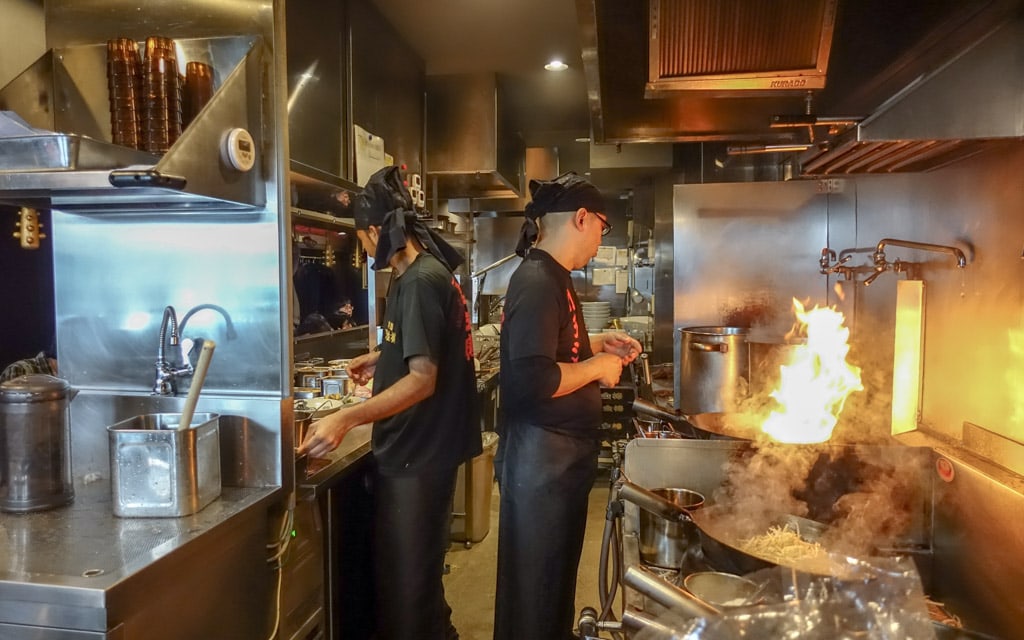
Most of the space inside the restaurant was taken up by an open-air kitchen run by workers dressed in black.
Surrounding the kitchen was an L-shaped counter. Each seat at the counter had a great view into the kitchen. While I was waiting for my bowl of ramen, I couldn’t help but watch the chefs using the woks, cutting chunks of pork, boiling noodles, and preparing bowls of ramen.
Premium Ramen
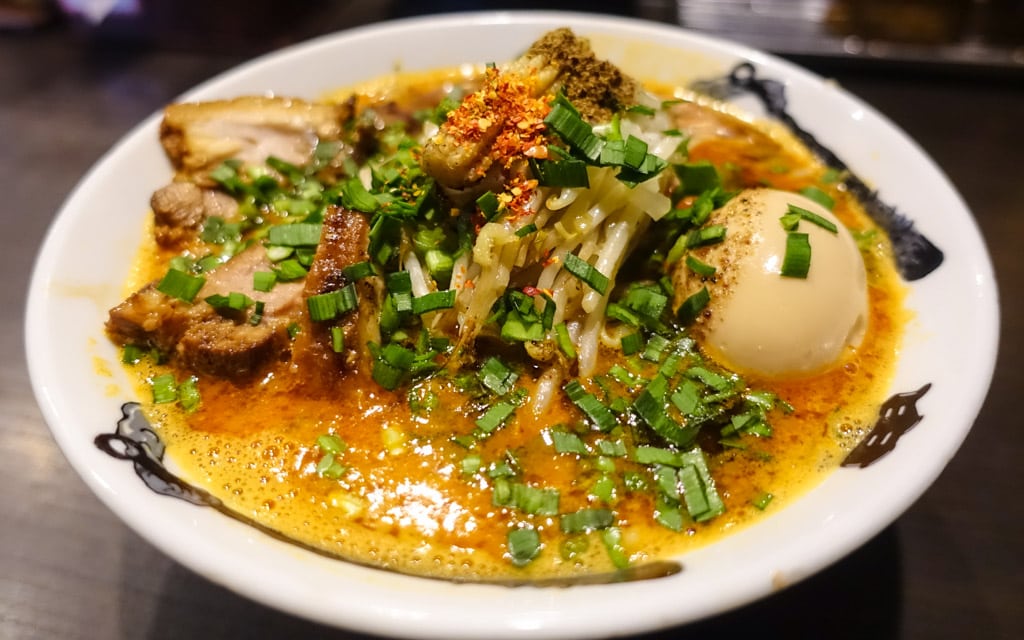
Since I wanted a little bit of everything in my bowl of ramen, I went for the Premium Ramen (1,050 yen or about $9.51). This bowl included pork, seasoned egg, bean sprouts, baby corn, coriander, and green onions. Not only was this bowl spicy, but it was beautiful to look at. Like a culinary work of art.
I love spicy foods and pushing the limits when it comes to foods that will make me sweat. But I’m not going to lie, I was nervous about ordering this bowl of ramen with high levels of both chili pepper and Sichuan pepperground chili pepper and Sichuan pepper. Not only was I worried about the heat but I was worried the peppers would overpower the flavors of the broth.
If you look closely, you can see the ground chili pepper and Sichuan pepper sitting at the top of the bowl. I recommend mixing everything up so you don’t get too much pepper in one bite.
Sichuan pepper, for those who have never had it before, is not so much spicy as it is smoky and mouth numbing. The more Sichuan pepper flakes in your bowl, the more your mouth will tingle and go numb.
To create the special broth, the chefs fried miso paste in a wok and added it to the aromatic pork broth. Additional chili pepper and Sichuan pepper were then added to the broth depending on the selected level of heat.
Flavorful and Fiery Red Broth
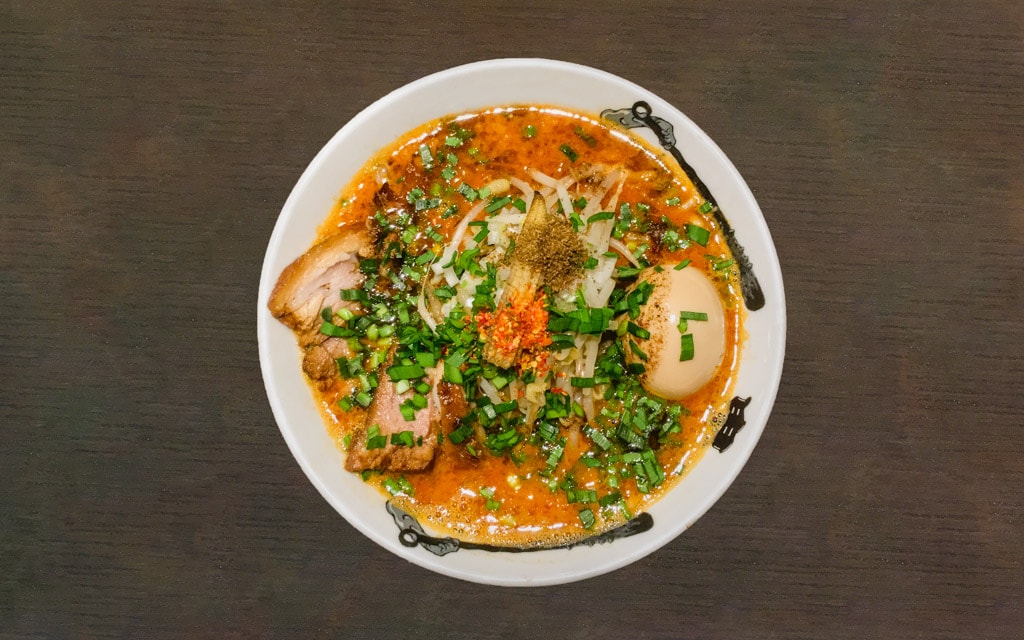
The flavorful broth was thick and oily from the pork. It was bright red, almost like fiery lava. The power of the Sichuan pepper kicked in immediately. I was surprised how numb and tingling my mouth was from the Sichuan pepper.
It was intense, somewhat overpowering. While spicy, I never felt the heat level was too spicy for me, just a good slow burn. I was wondering if I should have done the oni level for the chili pepper. Not only was the broth spicy but it was flavorful. It was rich, smoky, and salty from the pork.
The pork chashu (marinated braised pork belly) was in a league of its own when compared to other ramen shops in Tokyo. It was incredible and the highlight of this bowl. The huge pieces of pork, and I mean huge, were thick and meaty while extremely tender.
I couldn’t believe how the fatty bits of the pork just fell apart and melted in my mouth. Each time I took a bite of pork, I was rewarded with a unique taste whether is was salty, rich, or sweet. Even better, the pork became spicy as it soaked up the flavors of the broth and peppers.
The pork was perfection. I only wish all the ramen shops in Tokyo would prepare their pork the same way.
The noodles, which are usually the star of any bowl of ramen, were delicious but basic. The generous amount of noodles were thick and wavy with a good bite to them. I enjoyed how the noodles seemed to soak up all the rich, thick, spicy flavors of the broth.
Finishing off this bowl of ramen were bean sprouts, a seasoned egg, and baby corn. The bean sprouts were tender and slightly stringy. The generous amount of sprouts added a fresh, crunchy bite to the ramen.
While the pork was the star, the seasoned egg was just as impressive. Sure it was basic, but there was something satisfying about a perfectly cooked soft boiled egg. The egg exploded with a rich, creamy, runny golden yolk that complemented the heat of the broth.
While I have seen corn in ramen before, especially in Sapporo, it’s not something I encounter everyday. The crunchy and lightly fried baby corn was sweet and turned spicy as it soaked up the spicy flavors of the broth.
Service
At most ramen restaurants in Japan, interaction with workers is often limited. It was no different at Karashibi Miso Ramen Kikanbo. At the servers and workers in the kitchen seemed friendly and greeted every guest as they entered and left. The line moved along quickly, my food arrived moment after sitting, and the food was delicious. No complaints from me.
Conclusion
I can say without a doubt that the ramen served at Karashibi Miso Ramen Kikanbo is one of the spiciest bowls of ramen served anywhere in Tokyo. Whether you enjoy spicy foods or not, the ramen served at Kikanbo was rich, delicious, and prepared better than almost anything you can find in Tokyo. The spicy chili pepper and mouth numbing Sichuan pepper made each bowl that much better.
Pros
- Delicious spicy, fiery red broth
- Customizable bowls of ramen
- Interesting devil themed interior
- Great views of the kitchen from each seat
Cons
- Cash only
- Expect a wait
- Chili pepper wasn’t as spicy as I was hoping
Hours
Monday-Saturday: 11:00AM-9:30PM
Sunday: 11:00AM-4:00PM
Address
2 Chome-10-9 Kajicho, Chiyoda, Tokyo 101-0044, Japan
GPS Coordinates: 35.693701,139.772408
Map
Last Updated on January 31, 2024
Related Posts